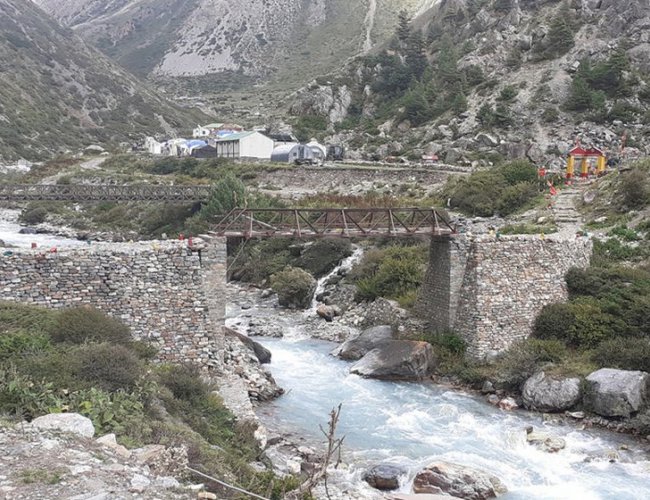
Ancient Hindu scriptures say Parikrama (circling) around Mount Kailash, the abode of Lord Shiva, after a dip in the ice-cold waters of Lake Mansarovar gives Mukti, absolve devotees of their sins, thus liberating them from the cycle of birth and death. Relations between historically friendly neighbors India and Nepal, from where most Hindu, Buddhist and Jain devotees come from, are encountering problems on the road to this ultimate pilgrimage site, constructed by one without consulting the other. The dispute is over a piece of land, Kalapani, claimed by both India, constitutionally secular but now ruled by devout Hindus and Nepal, historically world’s only the Hindu Kingdom which has just become a secular republic ruled by the world’s first elected Marxists-Leninist-Maoist government. The “Heaven on Earth” itself is in the Tibetan Autonomous Region (TAR) of politically atheist China.
On the face of it, this is an issue between Nepal and India concerning a piece of land in the remote Himalayas. But the Central Himalayas has emerged as one of the epicenters of the post-Cold War global paradigm flux with changing histories and geographies of living heavens for some hells for others. In such critical times, more than ordinary devotees, scholars, leaders and diplomats from both sides may be in greater need of Lord Shiva’s blessings to open their “Third Eyes” to the lessons of history, visualizing a picture far beyond the immediate geography.
In the immediate aftermath of changing maps, heated debates calling their own claims as based on historical evidence and questioning the motive of the other as acting “on the behest of others”, a “cooling down” period to prevent the situation from further escalation and preparing the environment for talks may be needed. But sooner than later both must meet to resolve the problem through serious and friendly negotiations. For progress, where should they start?
Test of Friendship: “I have returned to this beautiful country as a friend and I am happy to come here as Prime Minister".With these words, on the visit to Nepal in early August 2014, soon after his election, in the first visit by an Indian Prime Minister in 17 years, Narendra Modi clearly won the hearts and minds of Nepalis, as seen in the thunderous applause inside the Constituent Assembly (CA) hall where he spoke and the public mood outside. With one speech Modi was able to not only highlight the significance of the age-old and wide-ranging India-Nepal relations but virtually address all the issues bedeviling the vital but complex relations for so long. It was a Godsend message to realize the future potential of relations between the two oldest and closest South Asian neighbors.
Following up on his laudable Neighborhood First initiative, Modi further said, “Since the day I entered the Prime Minister's office, strengthening the relationship with Nepal is one of the top priorities of my government”. It naturally raised hopes of transformation in relations. Contrary to Modi’s wishes and hopes of well-wishers on both sides, why has India Nepal relations not only followed the same old pattern of ups and downs but even experienced some historic lows during his tenure?
Ill-advised and ill-timed: India imposed an economic blockade after Nepali leaders decided to go ahead with the promulgation of the current Constitution by the CA, itself an outcome of Indian backing, making Nepal the secular Federal Democratic Republic as planned in September 2015, despite Indian suggestion of postponement. This ill-advised Indian move affected the daily lives of common Nepalis.
The current border tension was triggered by the Sino-Indian agreement during Modi’s visit to China in 2015 to enhance their bilateral trade passing through territory also claimed by Nepal. Both sides had agreed to resolve the problem through bilateral negotiations, thus accepting the area as disputed. It escalated after India chose to ignore Nepal’s repeated diplomatic notes and request for a meeting of the Foreign Secretary-level committee, agreed by Modi himself with his Nepali counterpart. Why then the ill-timed 8 May rush to inaugurate the road to Mansarovar passing through disputed Kalapani, amidst the serious preoccupation with COVID 19?
The insensitive comment a few days later by the Indian Army Chief and some Indian analysts that Nepal may have raised the Kalapani issue on someone else’s behest (read China), coupled with verbal assaults on Nepal, attack on Nepali daughter Manisha Koirala, a Bollywood superstar, by Indian media, as an example, touched the historically independent-minded popular Nepali psyche. The pressure of public opinion forced the Oli Government to react by declaring and later publishing the new Nepali map including Limpiadhura which India calls “artificial territorial expansion” and “unjustified cartographic assertion”. But in Nepal, there is rare consensus among political parties on this map, now adopted unanimously by Parliament to amend the national emblem in the Constitution. India has termed this “untenable” and “violative” of the understanding to resolve the issue through bilateral negotiations.
The immediate mood of frustration on both sides is understandable. A short “cool down period” may be needed. But the situation, if not resolved skillfully and quickly, risks taking Nepal India relations to a new low making them “so near yet so far” for a longer stretch of time than ever experienced in the past, ultimately hurting the interests of both.
3 Steps Roadmap: The following roadmap aims not only to prevent the situation from further deterioration but also prepare the ground for progress in strengthening relations on a new even keel:
- Prevention: Kalapani has been an issue in Nepal-India relations since long. Despite Nepal’s longstanding claim, when Indian officials and even scholars ask questions and suggestions such as “On whose behest is Nepal ratcheting up things against India?” “Nepal might have raised the Lipulekh issue at China’s behest”? the Nepali side feels compelled to respond “If Indian scholars, leaders, officials and diplomats want better relations one of the first things they must do is get rid of the thinking of Nepal, a historically independent nation of 29 million tolerant, peace-loving proud and brave people, the well-known Gorkhas included, incapable of raising issues of what it regards as its vital national interest and dignity on its own”.
Both sides must utilize the “cool down” period to recognize the problem and change misperceptions. Indians must stop seeing the China card in everything Nepal does. Nepalis must not see the India hand in all things going wrong in Nepal. Both sides must prevent the situation from deteriorating further, hardening positions making it difficult to come to a reasonable settlement later.
Preparation: The Sugauli Treaty of 1816, the only Boundary Treaty between India and Nepal, gives legitimacy to the Nepali claim of the territory East of the Kali river. Many maps prepared by the British themselves show Limpiadhura as the source of the Kali. The British, having realized the strategic value of the area in their Great Game competition, seem to have changed the maps later. Independent India, inheriting that map, claims effective control of the disputed areas. Nepal too has proof of conducting election, census, registration, tax receipts, etc.
Obviously, not to allow pieces of land affect the cordial friendship, leaders agreed to entrust border delineation and demarcation to a technical committee. It is reported to have resolved 98 percent of the problem except for two places one of which is Kalapani. Both sides should now prepare thoroughly their documentations at the technical levels but also create the environment for serious negotiations to start without much further delay.
Once negotiations start both sides must give patience hearing to each other with an open mind. Preparing mentally, politically and through public diplomacy to accept the outcome of the negotiations based on historical proofs, the authenticity of the documents and each other’s long-term needs, interests and sensitivities is even more important. Meetings of the Foreign Secretaries as soon as possible should prepare the ground for political negotiations. All preparatory works and negotiations should be guided by the desire to resolve the border issue once and for all and transform relations to a much higher level of understanding, cooperation, mutual trust and confidence, lack of which is the main problem.
- Progress: Different people characterize Nepal India relations as, historic, deep-rooted and wide-ranging. Roti-Beti encompasses the life and livelihoods of peoples on both sides. Nepal India relations are such that if one side gets hurt the other feels the pain. Examples of Nepali fathers, sons and brothers dying when India goes to wars, numerous Nepalis dying in the Uttarakhand floods, Indian businesses suffering along with Nepalis from any disruptions of border trade and Indians downstream in Bihar bearing the brunt of the flooding in Nepal during Monsoon substantiate this assertion.
Guided by the common civilizational wisdom of “Basudhaiba Kutumbhakam” Nepal and India have enjoyed the benefits open border between two sovereign, independent nations, an idea even countries regarded as advanced are beginning to understand and emulate. Once the current phase of tribal/territorial nationalism, contrary to the dynamics of time and technology, passes, the evolution of the State system with greater integration and open borders are sure to return as a global trend. One does not have to go far to find an example of border problems settled through give and take. If understood and managed well Nepal-India relations can present a model of inter-state relations in the 21st Century and beyond.
Conclusions: The current state of relations between India and Nepal may have many facets but at the root is the inability to comprehend the paradox of proximity, vitality but also the complexity of proximity in inter-state relations. This is exacerbated by the unwillingness to decode the matrix of Indo-Nepal relations, resolving the Sovereignty, Resources and Security (SRS) conundrum. Ironically, common people on both sides understand the significance of good Nepal India relations. But, stuck with outdated ideas and practices, it is the scholarship, leadership and diplomacy that needs to comprehend the past significance and future potential of this relationship.
Crisis of comprehension and trust deficit created by mismanagement of relations with excessive politicization on one side over bureaucratization on the other is mainly responsible for the ups and downs in Indo-Nepal relations. De-politicization and de-bureaucratization with enlightened leadership supported by competent professionals can help reset relations for a much higher level of welfare of the people on both sides. On the contrary, continuing “myopic misjudgment” could be problematic for both, even disastrous for the entire Central Himalayas. To avoid it, understanding of history and geography of the trans-Himalayas but not remaining their prisoners is critical.
Nepal and India have enjoyed close bonds of history, geography, politics, economics, culture and religion since long. Lord Shiva’s blessings will hopefully open the eyes of politicians and diplomats of both sides to also find ways to travel together on this new highway to Heaven on Earth.
…………………..
“daring, delightful and transformative” Ariana Huffington, Huffington Post commenting on the author’s book Nepal India China Relations in the 21st Century













